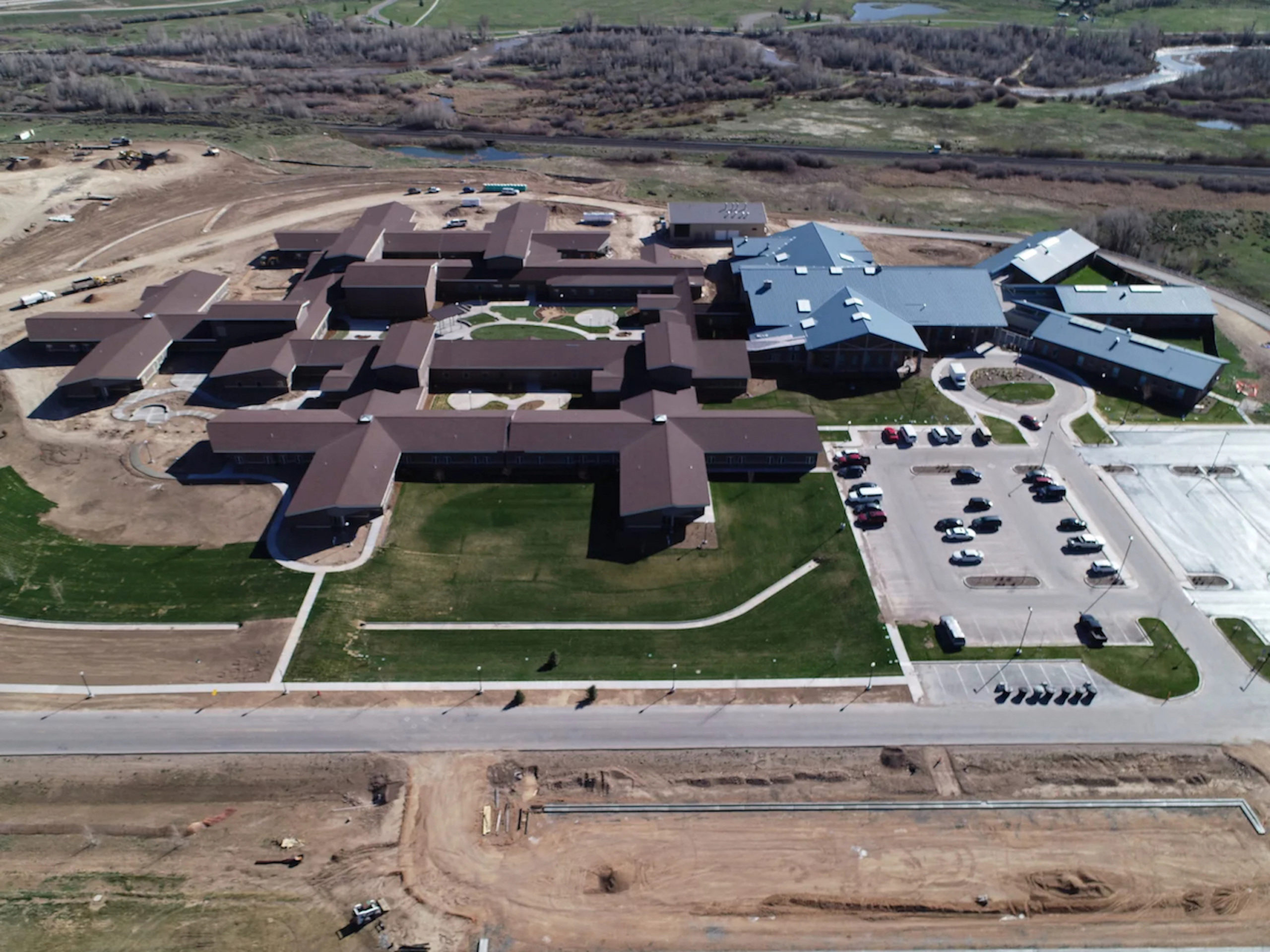
• A national report found Wyoming had the nation’s highest rate of people in jail waiting to get care at the state hospital.
By Madelyn Beck, WyoFile.com
A new survey highlights Wyoming’s continued struggle to provide beds for patients at its state-run psychiatric hospital.
National nonprofit Treatment Advocacy Center — which focuses on eliminating barriers and improving treatment for people with severe mental illness — released a report Wednesday that showed Wyoming’s challenges are particularly stark when compared to other states.
The nonprofit has long fought for reform in a system where people with severe mental challenges often end up in jail before receiving the treatment that could’ve prevented incarceration in the first place, it has stated.
The Wyoming Department of Health expressed concerns over the report’s accuracy and the use of certain numbers, though report authors cite data provided by the department.
People treated at the Wyoming State Hospital include those who have been charged with crimes and those who haven’t. As noted in the report, state hospitals nationwide treat varying amounts of both.
Using surveys from 2016 and last April through August, some key Wyoming stats in the report include:
People in Wyoming jails spend an average of 203 days — or 6.8 months — waiting for a bed at the state hospital.
Wyoming had the largest number of incarcerated people per 100,000 waiting for admission to the state hospital: 72 total.
More than half of the state hospital’s beds were occupied by people there via incarceration.
Wyoming had the highest number of beds per 100,000 population occupied by patients who were ready to be discharged. It reported 25 total at the time of the survey, or 35% of the hospital population.
21% of all beds at the state facility were being used by those who were found not guilty by reason of insanity.
The report also found that Wyoming lost a greater percentage of usable state hospital beds between 2016 and 2023 than any other state — dropping from 201 to 72.
However, those numbers are disputed.
Health Department spokesperson Kim Deti noted that the number of available, usable beds fluctuates regularly because of factors like individual patient needs and staffing.
“There is competition everywhere and at all levels for health care staff,” she said, adding that the department aggressively works to attract more people, and has looked at options like higher pay, educational support and leave time. “Over the last year in Evanston we have had some good progress toward improved vacancy rates.”
As of Jan. 23, there were 95 patients at the state hospital, Deti stated, compared to the 104 total physical beds.
Having more than 85% of beds filled is considered a shortage, the report noted.
“Higher occupancy rates have also been associated with increased mortality in the 30 days after discharge, including an increased risk of suicide,” it states.
There was also disagreement between the health department and the study over bed accounting in 2016. Report authors cited data they said came directly from a state hospital administrator, but the health department stated the total physical beds has been 104 for “maybe decades.”
“The main thing to know is that our operational capacity has been 104 for a long time and our census is currently close to that,” Deti stated.
Digging into the details
According to study author Shanti Silver, the Wyoming Department of Health self-reported that 25 state hospital patients were ready for discharge at the time of the survey. The advocacy group’s executive director, Lisa Dailey, went on to tell WyoFile that this patient group is receiving more attention lately.
“The [state hospital] has the highest level of care,” she said. “There are definitely people who are there and would be stable enough to be in a less secure setting, but there isn’t anything that’s at the right level of security that would be safe for them in the community.”
That can include geriatric patients with dementia, she said.
“As a result, since that population is stuck in those beds, and they’re not really able to be discharged, those beds are not available for the population that would normally be able to be moved into that higher level of care,” she said.
Still, sending people home from treatment too early can also lead to bad outcomes like self-harm and arrest, according to the Treatment Advocacy Center.
Deti noted that there are efforts to create more spaces for patients in Wyoming, including at the state-run Wyoming Life Resource Center in Lander.
“We recently rebuilt this facility as well and have added a skilled nursing facility there,” Deti stated. “The intent is to move a number of long-term clients from Evanston to Lander. This has started, but is moving ahead more slowly than we’d like due to staffing challenges … We anticipate this will help with the waiting lists that cause so much frustration.”
Behind bars
The people identified in the report as “forensic patients” at the state hospital — or those at the hospital because of their involvement with the criminal justice system — fall into a few categories, according to Deti.
“When a person who is charged with a crime is at [the Wyoming State Hospital], they are there for a competency evaluation or attempting to be restored to competency or have been found through the legal system to be not guilty due to a mental illness,” she stated.
The numbers of those patients can be affected by the legal system, she added, like when “a few years ago we saw an increase in the number of WSH services requested for misdemeanor crimes.”
For the Treatment Advocacy Center, this patient population would ideally get help long before they ended up breaking the law or falling into the hands of local law enforcement.
“When people with [severe mental illnesses] are detained in jail while in the middle of a mental health crisis, they may gain additional charges due to disruptive behaviors that are symptoms of their illness, get sicker as they spend extended periods of time without treatment, or even die from causes such as dehydration,” the group’s study says.
But because the problem often ends up on their front door, Dailey said, “law enforcement can sometimes be among the most vocal supporters of efforts to reform.”
This is true of groups like the Wyoming Association of Sheriffs and Chiefs of Police, or WASCOP.
“One of the top three topics of discussion since I’ve come on board as executive director is around mental health,” said WASCOP Executive Director Allen Thompson. “If we can divert those people [with severe mental illness] to the services that they need prior to the actual arrest, or processing through criminal court, then everyone’s better off treatment-wise, monetarily and impact on law enforcement in the community.”
Thompson said he’s grateful the information in this survey is available, concerning though it may be.
“It’s very impressive the amount of data that’s in that document and how that can inform all of us in Wyoming going forward on what the best things that we should be doing around mental health,” he said.
Thompson said there is a lot happening at the local level to support mental health in Wyoming — like crisis stabilization units and a diversion pilot program to keep people out of jail in Campbell County — but continued efforts are still needed. Dennis Green took his own life in a Campbell County holding cell in September and the suicide rate for the state’s county jails is the fourth-highest in the country. For its part, he said, WASCOP is pushing for more resources so law enforcement can link up people to telehealth counselors.
Police also spend significant time transferring patients to state hospitals, which could take hours in Wyoming because the facility is in the southwest corner of the state.
While Thompson doesn’t believe that’s the largest concern when it comes to mental illness in Wyoming, he said, “it definitely factors into our daily ability to do the law enforcement work back home.”
A 2017 study by the same nonprofit Treatment Advocacy Center found that law enforcement agencies nationally spent about 10% of their budget and 21% of their time responding to and transporting people with mental illness.
Takeaway
This study’s latest data only captured a moment in time, surveying state hospitals from April to August, and some states didn’t contribute statistics for items like the number of patients they had who were ready for discharge. States can also report data using different methodology than Wyoming, showing that their state is either better or worse off.
However, Dailey stressed the continued need for more local, lower-level resources for those who could potentially leave the state hospitals and open up beds for those who need them the most.
“It’s better for the people who are ready to be discharged, but it also frees up a lot of beds and overall makes your system function better,” she said.
Of course, this is easier said than done in a state with the nation’s smallest population and limited funding.
WyoFile is an independent nonprofit news organization focused on Wyoming people, places and policy.





